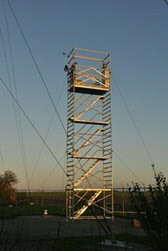PhD project: Isotope measurements as a tool to study sources and processing of carbonaceous aerosol particles | Katrin Zenker
Name: Katrin Zenker
Supervisor: Dr. U. (Ulrike) Dusek (Centre for Isotope Research, ESRIG/RUG)
Period: November 2014 – October 2018
Summary
Atmospheric aerosol particles influence the climate system of the earth and the human health in a way, which is not yet completely understood. One of the most important constituents of aerosol particles are carbonaceous components. The analysis of these in combination with the investigation of the carbon isotopes 13C and 14C allows a better characterization of the aerosol particles. With the help of radiocarbon (14C) measurements it is possible to differentiate between fossil and contemporary carbon sources. The analysis of the stable carbon isotope 13C is quite new in the field of aerosol science and it allows to investigate the ageing and transformation processes of aerosol particles. In the course of this project a long term sampling campaign has been conducted to investigate the sources and the processing of aerosol particles in the atmosphere with the help of carbon isotope measurements.

In autumn 2015 and during the year 2016 aerosol particle filter samples have been collected using a high volume particle sampler and two impactors at the measurement station in Lutjewad (see picture for setup). This special location allows us to sample aerosol from different air masses, coming from the sea and being mainly uninfluenced by human activity and coming from the land, where anthropogenic activities play a major role in the production of aerosol particles. Sampling was conducted for at least one month in each season of the year and filter were changed in dependence of the main air mass origin.
Currently the collected aerosol particle filter samples are analyzed for carbon mass concentration and carbon isotopic composition. Results will help to understand seasonal differences in sources and transformation processes of aerosol particles also in dependence of meteorological parameters.
